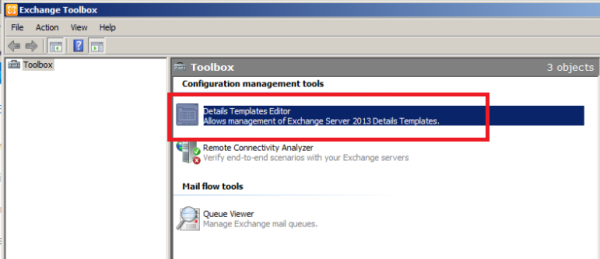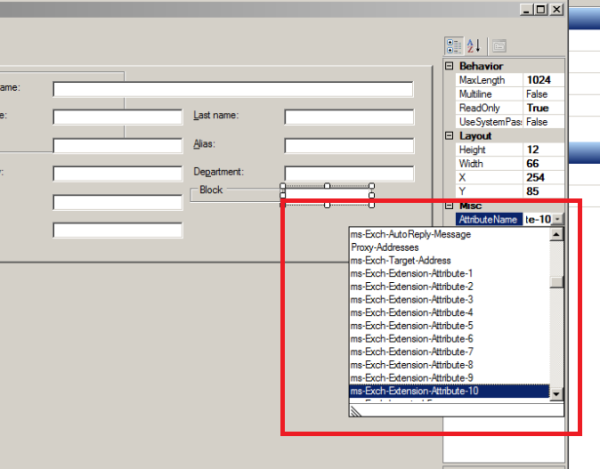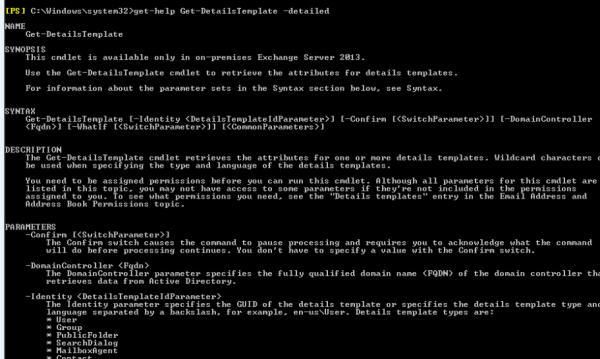Details Template Editor is used to modify or add extra information in the objects properties which are accessed through GAL.
For Example if company demands to have a column called Block or Cabin number to be added in each and every user’s mailbox to be displayed via GAL .We can use the details template editor and create new columns for the same. So by doing this when a user resolves any mailbox from the GAL and access their properties then he/she would be able to see the created object entries (Eg: Cabin number or Block).
In this example we will see how to create an additional column for Building Block which needs to be populated and visible in the user properties when end users accessed from GAL.
Details Template Editor can be modified by using Exchange toolbox as well as Exchange Management Shell. We will look through how to modify them with Exchange Toolbox.
Go to start all programs and Open Exchange Toolbox.
Unlike in Exchange 2010 we have only three configuration management tools as below and open Details Template Editor
Select preferred language and the preferred template type for which we need to add the new columns
There are multiple template types (Contact, User, Group, Public Folder, Mailbox Agent etc..,)
So ensure that you choose the correct Template Type.
And then it opens up the editor page as below
Here we have 2 options over the left
Group Box – When we double click on this option it creates an empty new box where the specified value is entered.
Label – A unique name defined for the newly created group box like (department, Alias as shown in above picture)
Now double click on the group box over the left and it creates a new empty column where the value needs to be displayed.
Over the right editor pane we have the layout height width adjustment option by which we can alter the values and bring it to look uniform with the other group boxes.
Now create a new label box by double clicking on the label icon and drag it to the newly created group box.
Now im entering the value Block in my example in the text. You can enter the desired value to appear in the GAL object.
We are done with creating the template. Now we need to assign a attribute to this newly created group box since no attributes will be linked with newly created group box.
Do the below steps to link a unassigned attribute to the newly created Group box.
In the right editor pane select any one of the unassigned attribute.
Once done click on file and we have an option called save
Run the below command to populate this value to any user via GAL
Set-Mailbox Usermailbox -CustomAttribute “specify the value”
In my example im setting this value for Exchangequery Mailbox
Set-Mailbox Exchangequery -CustomAttribute10 “B”
Note: By default this new value will not be created for any user and displayed in the GAL. We need to run the above command for the users to display this value in the GAL.
Now we can see this value is populated for the user we have set. This value will be displayed in Outlook when we see the properties of this user and new value Block with the value B will be displayed.
We can edit details template using exchange management shell as well
We can use below command to see the accepted property types in details template.
Get-DetailsTemplate | Get-Member
We can run the below commands to see the examples
Get-DetailsTemplate – Examples
To get the detailed information we can use the below parameter as well.
Get-Help Get-DetailsTemplate –Detailed
It’s better to use the Exchange Toolbox for creating new details template since there are multiple attributes involved and Details Template Editor is much user friendly. We can use Exchange Management Shell to modify or add any entries for users in the custom attributes assigned.
We are done with creating custom entries for objects using details template editor.
Sathish Veerapandian
















As the admin of this website is working, no hesitation very
soon it will be well-known, due to its quality contents.
LikeLike
Thanks for your comments Buddy 🙂
LikeLike
Thanks a lot for your valuable comments much appreciated
LikeLike
Helpful info. Fortunate me I found your site accidentally, and I am stunned why this
twist of fate did not came about earlier! I bookmarked it.
LikeLike
Thanks for your comments
LikeLike
I think that what you said was very logical. But, think
about this, what if you added a little information? I am not saying your content is not good, but suppose you added something
to possibly grab folk’s attention? I mean Details Template Editor Exchange 2013 | msexchangequery – (Microsoft MVP- Exchange Server) is a little plain. You ought to
peek at Yahoo’s front page and see how they create article
titles to get viewers to open the links. You might add a related video or a pic or
two to get people interested about everything’ve got to say.
In my opinion, it would make your blog a little livelier.
LikeLike
Thanks for your valuable inputs and would be happy if you get me some suggestions
LikeLike
Thankk you for this
LikeLike